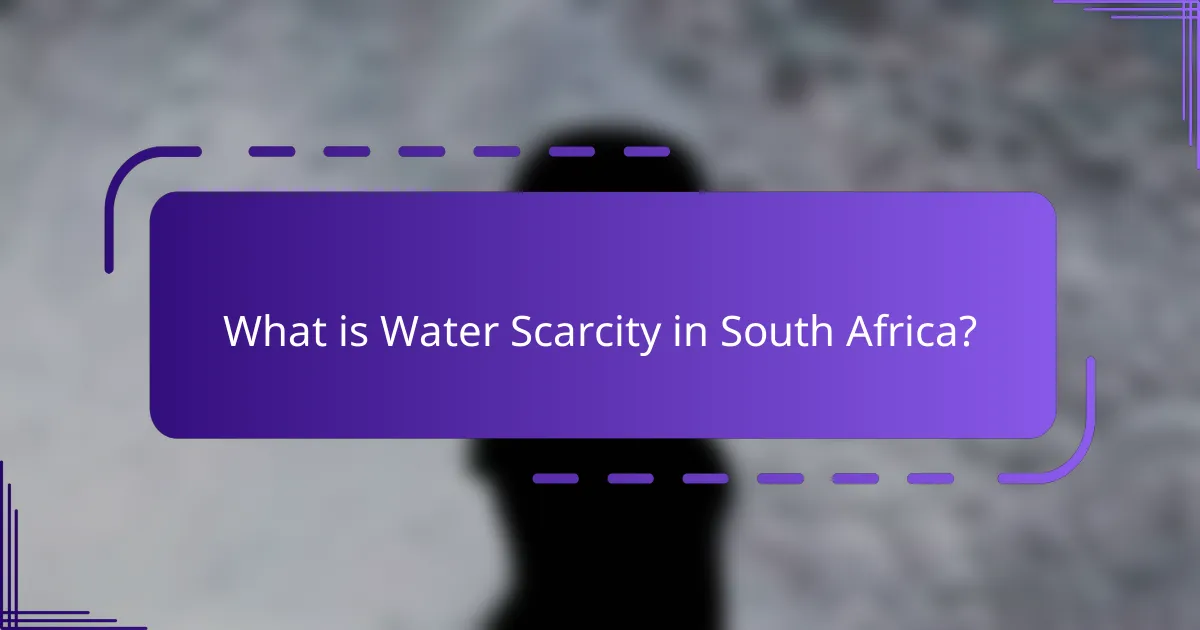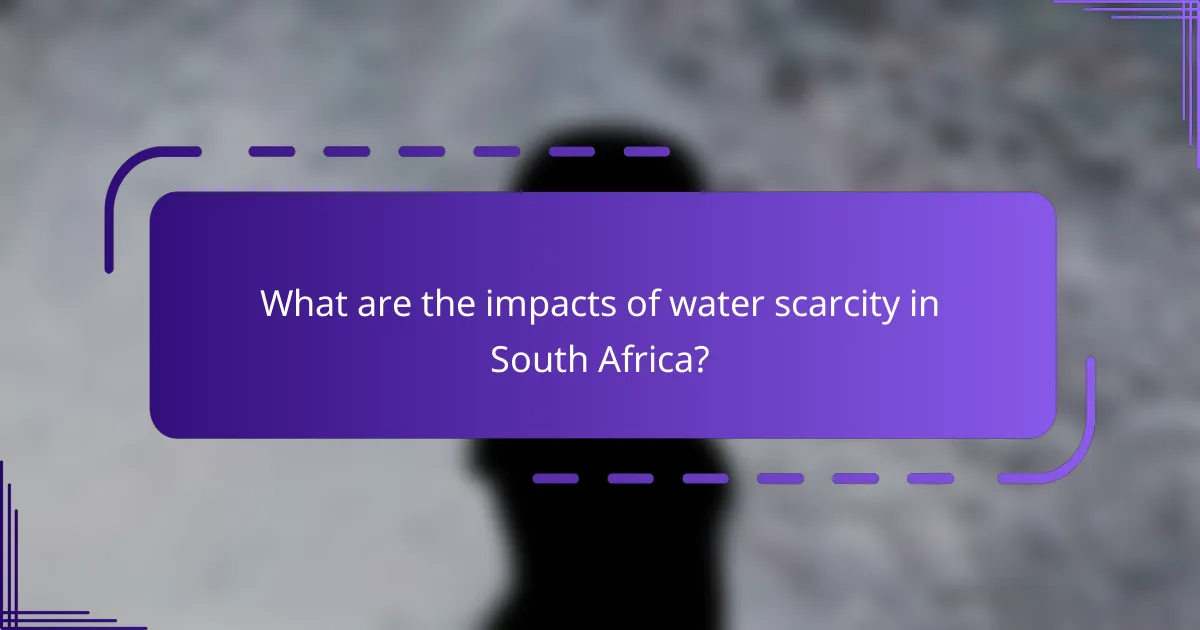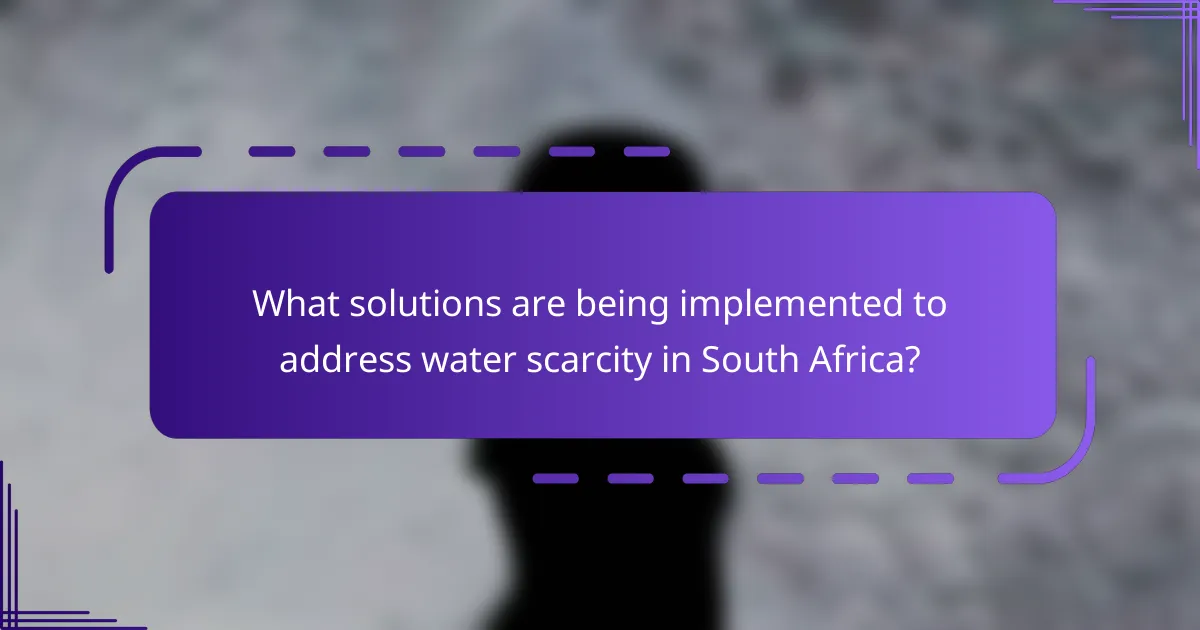Water scarcity in South Africa is characterized by the insufficient availability of fresh water necessary to meet the demands of its population and agricultural sector. Contributing factors include climate change, population growth, and inefficient water management practices, leading to approximately 14 million people facing water shortages. The impacts of this crisis are profound, resulting in decreased agricultural productivity, heightened health risks due to waterborne diseases, and economic instability as water-dependent industries struggle to operate. In response, South Africa is implementing various solutions such as water recycling, desalination, rainwater harvesting, improved irrigation techniques, and public awareness campaigns aimed at enhancing water availability and sustainability.

What is Water Scarcity in South Africa?
Water scarcity in South Africa refers to the insufficient availability of fresh water to meet the demands of the population and agriculture. This condition is exacerbated by factors such as climate change, population growth, and inefficient water management. According to the South African National Development Plan, around 14 million people experience water shortages. Additionally, the World Resources Institute ranks South Africa among the 30 most water-stressed countries. These issues lead to significant economic and social challenges, including reduced agricultural productivity and increased health risks.
How is water scarcity defined in the context of South Africa?
Water scarcity in South Africa is defined as the insufficient availability of freshwater resources to meet the demands of the population and ecosystem. This condition arises from factors such as prolonged droughts, climate change, and inefficient water management. South Africa is classified as a water-scarce country, with an average annual rainfall of only about 495 mm, significantly lower than the global average of 860 mm. Additionally, the country faces challenges like pollution and over-extraction of water resources, exacerbating the scarcity issue. According to the South African Department of Water and Sanitation, approximately 14% of the population lacks access to clean water, highlighting the severity of the situation.
What are the different types of water scarcity affecting the region?
There are three main types of water scarcity affecting the region of South Africa. The first type is physical water scarcity. This occurs when there is not enough water available to meet the demands of the population. According to the World Resources Institute, South Africa is classified as a water-scarce country, with an average annual rainfall of about 450 mm, significantly lower than the global average of 860 mm.
The second type is economic water scarcity. This happens when water resources are available but are not accessible due to infrastructure challenges. Many communities in South Africa lack proper water supply systems, leading to inadequate access to clean water. The South African Human Sciences Research Council reports that millions still rely on unsafe water sources.
The third type is seasonal water scarcity. This refers to periods of high demand for water that exceed supply, often during dry seasons. Seasonal rainfall patterns can lead to drought conditions, exacerbating water shortages. The South African Weather Service indicates that droughts have become more frequent, impacting agricultural production and water availability.
How does climate change contribute to water scarcity in South Africa?
Climate change significantly contributes to water scarcity in South Africa. Rising temperatures lead to increased evaporation from water bodies and soil. This results in reduced water availability for agriculture and drinking. Additionally, altered rainfall patterns cause prolonged droughts in some regions. According to the South African Weather Service, rainfall has decreased by about 10% over the past century. Increased frequency of extreme weather events further exacerbates the situation. These changes strain already limited water resources. Climate change thus poses a critical challenge to water security in South Africa.
What are the historical factors leading to water scarcity in South Africa?
Historical factors leading to water scarcity in South Africa include colonial land practices and apartheid policies. Colonialism established inequitable water distribution, prioritizing European settlers over indigenous populations. This created a legacy of unequal access to water resources. Apartheid further entrenched these disparities, limiting water access for black communities. Urbanization and industrialization increased water demand without corresponding infrastructure development. Climate variability has exacerbated these issues, with prolonged droughts impacting water supply. Historical mismanagement of water resources has also contributed to ongoing scarcity challenges.
How has population growth impacted water resources?
Population growth has significantly strained water resources. Increased demand for water arises as populations expand. Urbanization leads to higher consumption in cities. Agriculture also requires more water to support larger populations. Over-extraction of rivers and aquifers results from this heightened demand. For instance, South Africa’s population grew from 40 million in 1996 to over 60 million in 2021. This growth exacerbates existing water scarcity issues. Climate change further complicates the situation by altering rainfall patterns. As a result, sustainable water management becomes increasingly critical.
What role does agriculture play in water consumption?
Agriculture is a significant contributor to water consumption, accounting for approximately 70% of global freshwater use. In South Africa, this percentage is similar, highlighting the sector’s critical role in water demand. Crop irrigation and livestock watering are the primary activities driving this consumption. For instance, irrigated agriculture requires substantial water resources to maintain crop yields. According to the Food and Agriculture Organization, this high demand can exacerbate water scarcity issues, particularly in regions with limited water availability. Efficient water management practices in agriculture are essential to mitigate these impacts and ensure sustainable water use.

What are the impacts of water scarcity in South Africa?
Water scarcity in South Africa leads to severe impacts on agriculture, health, and economic stability. Agricultural productivity declines due to insufficient water for irrigation. This results in reduced crop yields and food shortages. Health issues arise as access to clean drinking water diminishes. Waterborne diseases become more prevalent in communities. Economic growth suffers as industries reliant on water face operational challenges. Job losses occur in sectors like farming and tourism due to decreased water availability. Social tensions increase as communities compete for limited water resources. Overall, water scarcity poses significant threats to the nation’s sustainability and well-being.
How does water scarcity affect public health?
Water scarcity significantly impacts public health by increasing the risk of waterborne diseases. Limited access to clean water leads to poor sanitation practices. This can result in outbreaks of diseases such as cholera and dysentery. According to the World Health Organization, approximately 2 billion people lack safe drinking water. This situation exacerbates malnutrition and hinders proper hygiene. Furthermore, water scarcity can lead to mental health issues due to stress and anxiety. In South Africa, regions facing severe water shortages report higher rates of illness. Access to sufficient water is crucial for maintaining overall health and well-being.
What diseases are linked to water scarcity?
Water scarcity is linked to several diseases, primarily due to inadequate access to clean water. Common diseases include cholera, which spreads through contaminated water. Diarrheal diseases are also prevalent, affecting millions in water-scarce regions. Malnutrition can occur as water scarcity impacts food production. Skin infections may arise from poor hygiene due to lack of water. Additionally, vector-borne diseases like malaria can increase as stagnant water accumulates. The World Health Organization states that water scarcity exacerbates health issues, particularly in vulnerable populations.
How does water scarcity impact sanitation and hygiene?
Water scarcity significantly impacts sanitation and hygiene by limiting access to clean water for essential hygiene practices. Insufficient water supply hinders daily activities such as handwashing, bathing, and cleaning. This leads to increased prevalence of waterborne diseases. According to the World Health Organization, inadequate sanitation and hygiene contribute to approximately 1.5 million child deaths annually. Moreover, communities facing water shortages often resort to unsafe water sources, exacerbating health risks. In South Africa, areas with severe water scarcity report higher incidences of diseases like cholera and diarrhea. Thus, water scarcity directly correlates with poor sanitation and hygiene outcomes.
What economic consequences arise from water scarcity?
Water scarcity leads to significant economic consequences, including reduced agricultural productivity. In South Africa, this affects food supply and increases prices. Industries reliant on water face operational disruptions, leading to decreased output and job losses. Water scarcity can also hinder economic growth, as investments in affected regions decline. The agricultural sector, which contributes 2.5% to South Africa’s GDP, suffers greatly. In some areas, crop yields have dropped by up to 30% due to insufficient water. Additionally, water scarcity can increase the cost of water treatment and distribution, straining municipal budgets. These factors collectively contribute to a cycle of economic decline in water-scarce regions.
How does water scarcity affect industries and employment?
Water scarcity significantly impacts industries and employment by reducing production capacity and increasing operational costs. Industries that rely heavily on water, such as agriculture and manufacturing, face severe challenges. Crop yields decline due to insufficient irrigation, leading to reduced food supply and income for farmers. This can result in job losses in agricultural sectors. Manufacturing industries experience disruptions in processes that require water, causing delays and increased expenses. According to a report by the World Bank, water scarcity can lead to a 6% reduction in GDP in some regions. This economic downturn directly affects employment rates as businesses may downsize or close. Furthermore, industries may shift to areas with better water availability, leading to regional job displacement.
What are the long-term economic implications of water scarcity?
Water scarcity leads to significant long-term economic implications. It reduces agricultural output, affecting food security and farmers’ incomes. The World Bank estimates that water scarcity could reduce global GDP by up to 6% by 2050. Industries reliant on water, such as manufacturing and energy, face increased costs and reduced productivity. Job losses may occur in sectors heavily dependent on water resources. Additionally, water scarcity can increase the cost of water supply and sanitation services. This creates a financial burden on households and governments. Investment in water infrastructure becomes crucial to mitigate these economic impacts.

What solutions are being implemented to address water scarcity in South Africa?
South Africa is implementing various solutions to address water scarcity. These include water recycling and reuse programs. Desalination plants are being constructed along the coast. Rainwater harvesting initiatives are being promoted in urban areas. Improved irrigation techniques are being introduced in agriculture. The government is investing in infrastructure upgrades for water supply systems. Public awareness campaigns are being conducted to encourage water conservation. These solutions aim to enhance water availability and sustainability.
How are government policies addressing water scarcity?
Government policies are addressing water scarcity through a combination of regulatory frameworks, investment in infrastructure, and conservation initiatives. The South African government has implemented the National Water Act, which promotes equitable access to water resources. This act emphasizes the importance of sustainable water management and the protection of water ecosystems.
Additionally, the government has launched various programs aimed at improving water efficiency in agriculture, which is the largest consumer of water in the country. For instance, the Comprehensive Agricultural Support Programme provides financial assistance for water-saving technologies.
Investment in infrastructure projects, such as the construction of dams and desalination plants, is also a key focus. These projects aim to increase water supply in water-scarce regions. Furthermore, public awareness campaigns encourage responsible water use among citizens.
The government collaborates with local municipalities to develop integrated water resource management plans. These plans address specific regional challenges and promote community involvement in water conservation efforts. Overall, these policies aim to ensure long-term water security in South Africa.
What initiatives have been launched to improve water management?
Various initiatives have been launched to improve water management in South Africa. The National Water Resource Strategy aims to ensure sustainable water use and management. This strategy includes measures for efficient water allocation and conservation. The Department of Water and Sanitation has implemented the Water Conservation and Water Demand Management Program. This program promotes practices to reduce water waste and enhance efficiency. The government also supports the use of advanced technologies, such as smart water meters. These technologies help monitor water usage and detect leaks. Additionally, community-based projects focus on rainwater harvesting and groundwater recharge. These initiatives aim to enhance local water availability and resilience.
How is technology being utilized to combat water scarcity?
Technology is being utilized to combat water scarcity through innovations such as desalination, water recycling, and smart irrigation systems. Desalination plants convert seawater into potable water, addressing shortages in coastal areas. For example, the Cape Town desalination plant provides an alternative water source for the city. Water recycling technologies treat wastewater for reuse, significantly reducing demand on freshwater supplies. In South Africa, initiatives like the Water Research Commission promote the adoption of these technologies. Smart irrigation systems use sensors and data analytics to optimize water usage in agriculture. This technology helps farmers use less water while maintaining crop yields. Overall, these technological solutions are critical in managing and conserving water resources effectively.
What role do communities play in addressing water scarcity?
Communities play a crucial role in addressing water scarcity. They engage in local water management practices. This includes implementing conservation strategies and promoting efficient water use. Community-led initiatives often raise awareness about water issues. They also mobilize resources for infrastructure projects, such as rainwater harvesting. Research shows that community involvement improves water access and quality. For instance, in South Africa, local groups have successfully managed water resources in various regions. These efforts contribute to sustainable water solutions.
How can community-driven projects enhance water conservation?
Community-driven projects can enhance water conservation by fostering local engagement and awareness. These projects encourage communities to take ownership of their water resources. By involving residents in water management, they promote sustainable practices. Education initiatives within these projects inform individuals about water-saving techniques. Research indicates that community participation can lead to a 20% reduction in water usage. Collaborative efforts also facilitate the sharing of resources and knowledge. Furthermore, community-driven projects can attract funding and support for infrastructure improvements. This holistic approach ultimately strengthens the community’s resilience against water scarcity.
What best practices can individuals adopt to reduce water usage?
Individuals can adopt several best practices to reduce water usage. Fixing leaks in faucets and toilets can prevent significant water waste. Shortening shower times to five minutes can save gallons of water daily. Using a broom instead of a hose to clean driveways and sidewalks conserves water. Installing low-flow showerheads and faucets can significantly decrease water consumption. Collecting rainwater for irrigation helps utilize natural resources efficiently. Running dishwashers and washing machines only with full loads maximizes water efficiency. Choosing drought-resistant plants for landscaping reduces the need for frequent watering. Lastly, turning off the tap while brushing teeth can save up to 8 gallons per day. These practices contribute to water conservation efforts, especially in water-scarce regions like South Africa.
What practical steps can be taken to mitigate water scarcity?
Implementing water conservation techniques is essential to mitigate water scarcity. Rainwater harvesting can capture and store rain for future use. This method can significantly reduce dependency on municipal water supplies. Drip irrigation in agriculture minimizes water waste by delivering water directly to plant roots. Additionally, promoting drought-resistant crops can enhance agricultural resilience. Public awareness campaigns can educate communities about water-saving practices. Upgrading infrastructure to prevent leaks can improve water distribution efficiency. Regulatory measures can enforce sustainable water usage policies. Investment in desalination technology can also provide alternative water sources.
Water scarcity in South Africa is characterized by insufficient freshwater availability to meet the needs of the population and agriculture, exacerbated by climate change, population growth, and poor water management. Approximately 14 million people in the country experience water shortages, with significant impacts on agricultural productivity, public health, and economic stability. The article explores the various types of water scarcity, the historical and current factors contributing to this issue, and the resulting social and economic consequences. Additionally, it discusses potential solutions being implemented, including government policies, technological innovations, and community-driven initiatives aimed at improving water management and conservation efforts.